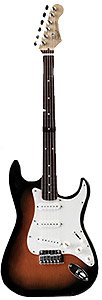 GMP has captured the essence of the Stratocaster in outstanding detail with this 1:3-scale replica, the first in the series. Features include a real wood neck contoured to match the real guitar, an accurately contoured die-cast body, moveable pickup selector switch, volume and tone controls, accurately scaled steel strings and a moveable tremolo arm. Each miniature comes with a display stand, wall mount and full-color collector's box.
GMP has captured the essence of the Stratocaster in outstanding detail with this 1:3-scale replica, the first in the series. Features include a real wood neck contoured to match the real guitar, an accurately contoured die-cast body, moveable pickup selector switch, volume and tone controls, accurately scaled steel strings and a moveable tremolo arm. Each miniature comes with a display stand, wall mount and full-color collector's box.Customer Review: The shrunken Strat
Really nice. I got the sunburst strat model, and the paint on the diecast body shows woodgrain. One detractor though, mine could have used a little more red in the sunburst - almost looks like the two tone fifties sunburst pattern - but I am just nitpicking. The things is beautiful. I think they should offer a fifties strat with a maple fretboard......
Customer Review: Mini Strat
This is a great looking collectible! A perfect looking tiny strat, right down to the last detail. I love the look of the finish - just like the real thing! I also love the wall hanger - it looks just like a regular guitar wall hanger, only small! Great detail and craftmanship in this item!
Everybody grows up dreaming about being a rock star, about being able to shred on an electric guitar and impress the masses. Even one of the most popular video games of today, Guitar Hero, is based around people's primal urge to play the guitar. The electric guitar has been the single most defining element of music for the 20th century and it's evolvement from the big band orchestra to the bands we know today.
Who Invented the Electric Guitar?
During the 1920's and 1930's many individuals and companies were experimenting with designs that would enable them to make guitars louder. With bands getting larger, and audiences getting louder, it was important to be able to hear the actual, individual instruments.
In 1924, Lloyd Loar of the Gibson Guitar Company was developing a means (an electric pickup) to pass the vibrations of the strings through a bridge to a magnet and coil, whereupon they were passed as electrical signals to an amplification device. By 1928 "electric guitars" were officially being marketed and sold to the public.
However, the problem with this was that in transferring the vibrations to a medium before being sent to an amplifier, the signal was too weak. So a more direct method had to be developed. The first to do this, and get the patent for it, was George Beauchamp, along with Adolph Rickenbacker and his company.
The guitar was known both as "The Pancake Guitar" and as "The Frying Pan" because of its appearance and because it was played flat in the musician's lap. Available from 1931 on, the guitar was made out of cast aluminum and steel.
Notable Early Achievements Following the Invention of the Electric Guitar
Before this, there were other models being experimented with by many other people. Les Paul, for instance, was working with attaching microphones to guitars. By the 1940s Les Paul would invent something much more successful, which was the solid wood body guitar.
It was designated as "The Log", because it was essentially just one piece of wood attached to a neck with pickups and hardware attached. Gibson later sold a solid body electric guitar endorsed by Les Paul starting in 1950 which could be mass produced.
It was Leo Fender in the late 1940s that developed the first commercially successful, solid body electric guitar. With a single magnetic pickup, it was known as the "Esquire", while the model with a double magnetic pickup was known as the "Telecaster".
In 1953 Fender introduced the mass-producible and world famous Stratocaster guitar. This guitar had several many unique elements, creative design features and improvements over the previous Telecaster model.
These mass-produced Gibson and Fender models are what took hold of a generation and caught on in popularity with many influential musicians of the time. These guitars changed the outlook, style and sound of music forever.
From humble beginnings, the electric guitar transformed an entire genre of art and was able to capture the emotions and feelings of entire generations of people. From guitar legend Jimi Hendrix to the Guitar Hero next door, electric guitars are now entirely synonymous with popular music.
Jay Villaverde is the owner of Vintage Guitar Center. A site dedicated to preserving the beauty and sound of vintage electric guitars You can find great deals on guitars from Gibson, Fender and many more manufacturers. If you love music and vintage guitars, this is a must see site.
aluminium fender stratocaster